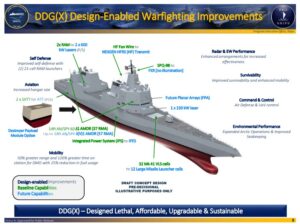
The Navy this week showcased the DDG(X) next large surface combatant's draft capabilities that could accommodate multiple directed energy laser weapons, hypersonic missiles, and a more powerful radar. The Navy is developing the DDG(X) as a new hull with new space, weight, power and cooling (SWAP-C) allowances for future advanced systems but while using the combat system of the new Arleigh Burke-class DDG-51 Flight III destroyer and an Integrated Power System (IPS) like the Zumwalt-class DDG-1000 destroyer. “DDG-51 Flight III…

 By
By 








